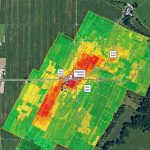Mycorrhizae: Boosting Yields Naturally
Mycorrhizae are complex, symbiotic associations between fungi and the roots of plants. The term “mycorrhiza” comes from the Greek words ‘mykes’, meaning fungus, and ‘rhiza’, meaning root.
In modern agricultural practices, mycorrhizal fungi are increasingly recognized for their role in enhancing plant health and soil fertility. These fungi form a symbiotic relationship with the roots of many crops, a relationship that is especially valuable for improving phosphate uptake. Phosphorus is a critical nutrient for plant development, yet its availability is often limited due to its poor solubility in soil. By applying mycorrhizal fungi as a soil amendment, farmers can improve the efficiency of phosphate absorption by plants.
Beyond facilitating better phosphorus absorption, mycorrhizal fungi contribute to a range of other plant benefits, including enhanced nutrient and water uptake, improved resistance against root pathogens, and better soil structure.
Types of Mycorrhizae Symbioses
The symbiotic relationship is categorized mainly into two types, differentiated by their interaction methods with plant roots: arbuscular mycorrhizae (AM), and ectomycorrhizae (EM).
AM fungi are characterized by the formation of arbuscules and vesicles within the host plant’s root cells. Arbuscules are tree-like structures inside the cells that facilitate nutrient exchange between the fungus and the plant, while vesicles serve as nutrient storage. AM fungi belong to the phylum Glomeromycota. This group is relatively small, with about 200 described species, but these fungi are widespread and can form symbiotic relationships with the roots of approximately 80% of all terrestrial plant species, including many crops.
Ectomycorrhizae (EM) fungi encompass a more diverse group, with species belonging to various fungal phyla, including Basidiomycota and Ascomycota. There are thousands of species of EM fungi, and they primarily associate with woody plants, especially trees in temperate and boreal forests.
Unlike AM fungi, they enable nutrient exchange, without penetrating the plant root cells’ walls. EM fungi develop an extensive hyphal network around the root surface and penetrate the root cortex’s intercellular spaces, forming a dense sheath. This mantle, which extends into the soil, augments the surface area for nutrient and water uptake.
Enhancing Phosphorus Uptake
Phosphorus is a critical nutrient for plants, integral to various biological processes including energy transfer, photosynthesis, and cell signaling. However, it is often present in soil in forms that are not readily available to plants. Mycorrhizal fungi play a crucial role in overcoming this limitation through several mechanisms:
Increased Surface Area: Due to its chemical nature, phosphorus is generally immobile in the soil, often becoming fixed in forms that plants cannot readily absorb. This immobility presents a major challenge for plants in accessing phosphorus. The hyphae of mycorrhizal fungi extend far beyond the root zone, significantly increasing the surface area for nutrient absorption. This extended hyphal network can access phosphate ions at much lower concentrations than plant roots can, effectively mining the soil for phosphorus.
Solubilization and Mineralization: Mycorrhizal fungi secrete organic acids and enzymes that solubilize phosphate compounds, converting them into forms that plants can absorb. This process not only makes phosphate more available to the host plant but also to other plants in the vicinity, demonstrating the fungi’s role in nutrient cycling within ecosystems.
Direct Transfer: Once phosphate is absorbed by the fungal hyphae, it is transported directly to the plant. This direct transfer mechanism bypasses the soil solution, which can be inefficient due to the binding of phosphate to soil particles.
Other Benefits of Mycorrhizal Associations
Beyond enhancing phosphate uptake, mycorrhizal fungi confer several other benefits to their host plants and the environment:
Improved Water Uptake: The extensive hyphal network of mycorrhizal fungi also enhances the absorption of water, which can be crucial in drought-prone areas. This increased water uptake efficiency helps plants to better withstand periods of water stress.
Pathogen Resistance: Mycorrhizal fungi can improve plant health by offering protection against root pathogens. The physical barrier formed by ectomycorrhizae and the biochemical changes induced in the plant by arbuscular mycorrhizae can both serve to deter or inhibit pathogenic microbes.
Enhanced Nutrient Uptake: Besides phosphorus, mycorrhizal fungi assist in the uptake of other essential nutrients, including nitrogen, potassium, and trace elements. This broad spectrum of nutrient acquisition supports overall plant growth and vitality.
Soil Structure Improvement: The growth of fungal hyphae through the soil helps to bind soil particles together, improving soil structure. Better soil structure enhances water retention, aeration, and root penetration.
Carbon Sequestration: Mycorrhizal fungi play a role in the global carbon cycle. Carbon fixed by plants through photosynthesis is partially transferred to the fungi, which can then be sequestered in the soil, contributing to soil organic matter.
Implications for Agriculture and Ecosystem Management
The benefits of mycorrhizal fungi have profound implications for sustainable agriculture and ecosystem management. Enhancing the mycorrhizal association through practices such as reduced tillage, cover cropping, and the application of mycorrhizal inoculants can improve crop yield, reduce the need for chemical fertilizers, enhance soil health, and minimize nutrient runoff.
Reduced tillage – Adopting reduced tillage practices significantly enhances mycorrhizal associations. By limiting soil disturbance, reduced tillage aids in maintaining the intricate networks of mycorrhizal fungi, crucial for effective phosphorus uptake and overall nutrient management. This conservation of mycorrhizal integrity allows for a more efficient transfer of nutrients to crops.
Cover crops – Cover crops play an important role in enhancing mycorrhizal symbiosis within agricultural systems by maintaining a continuous living root system throughout the year, crucial for the sustenance of mycorrhizal fungi. These crops contribute to the diversity of soil microbial habitats, supporting a range of mycorrhizal species and thereby support the resilience and biodiversity of the soil ecosystem. Additionally, cover crops improve soil structure, facilitating the growth of mycorrhizal networks.
Economic Advantages of Mycorrhizal Symbiosis in Agriculture
The application of mycorrhizal symbiosis in agriculture offers significant economic benefits. By enhancing nutrient uptake, particularly phosphorus, mycorrhizal fungi reduce the need for chemical fertilizers, leading to substantial cost savings. Moreover, the improved nutrient efficiency and stress resilience provided by these fungi contribute to increased crop yields and quality. These benefits are critical in today’s agricultural economy, where efficiency and sustainability are paramount.
Challenges and Future Directions
Despite the clear benefits, the practical application of mycorrhizal fungi in agriculture and ecosystem restoration presents challenges. These include the variability in effectiveness across different plant species and environments, and the complexity of establishing mycorrhizal associations artificially.
Further research is essential to optimize mycorrhizal applications in agriculture, restore degraded landscapes, and conserve mycorrhizal diversity.







